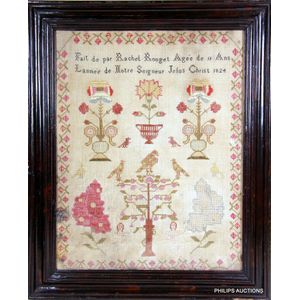Empire Style Sideboard with Inlays and Ormolu Mounts
You must be a subscriber, and be logged in to view price and dealer details.
Subscribe Now to view actual auction price for this item
When you subscribe, you have the option of setting the currency in which to display prices to $Au, $US, $NZ or Stg.
- Amboyna - Amboyna is a tree native to Indonesia (named after the Indonesian island of Ambon) and South East Asia, and when harvested the timber has a fragrant rose-like scent, and is of a rich brown colour, usually harvested from the burl of the tree with "birds-eye" markings . In furniture is is usually veneered and used for decorative effects on top quality pieces.
- Empire Style - The Empire style was a version of neo-classicism popular from 1800 to 1830, coinciding with the rule of Napoleon I from 1840-15. In England the style corrosponds with the Regency style and in the United States to the Federal style.
The style is inspired by classical Rome and Greece, as reflected in the decorative motifs in the the design such as paterae, guilloches, acanthus and swags, and pieces are lavishly decorated with applied gilded decoration. - Ebonised - Timber that has been stained or lacquered black in imitation of ebony. The process has been used since the Renaissance, but is most commonly found in late 19th century furniture, sometimes gilded and turned in imitation of bamboo. Furniture with an ebonised finish is not currently in vogue, and this is reflected in the price for such pieces.
- Ormolu - Ormolu was popular with French craftsmen in the 18th and 19th century for ornamental fittings for furniture, clocks and other decorative items. True ormolu is gilt bronze, that is bronze that has been coated with gold using a mercury amalgam. Due to the health risks associated with using mercury, this method of creating ormolu was discontinued in France in the 1830s. A substitute was developed consisting of about 75% copper and 25% zinc, however it was inferior to the bronze version. It was often lacquered to prevent it tarnishing.
- Mounts - Mounts are used to describe bronze, brass and ormolu adornments on furniture especially quality furniture in the rococo and classical revival style, and are also the cabinet makers' name for the metal fittings on furniture, such as hinges, locks and handles, and metal edges and guards which protect furniture from damage.
This item has been included into following indexes:
Visually similar items

Ornate gilt framed bevelled mirror, 77 cm x 57 cm

An Austrian Biedermeier ebonised and satinwood inlaid cabinet, the rectangular top with moulded cornice above a pair of glazed doors with lyre and sunburst pierced decoration, above arched panels enclosing four adjustable shelves, above a single large draw

An antique French sampler, 1824, by Rachel Rouget, aged eleven, a cross stitch and pulled work sampler in muted colours on broad weave linen with fruiting trees, flowers, pot plants, birds and two figures. Height 50.5 cm, width 41 cm

A Edwardian mahogany and rosewood inlaid sideboard, early 20th century, with refined Italian Renaissance influence, the tall stepped mirror backed sideboard with spindles and arched display galleries, bevelled glass side cabinets and a bow front extended s
